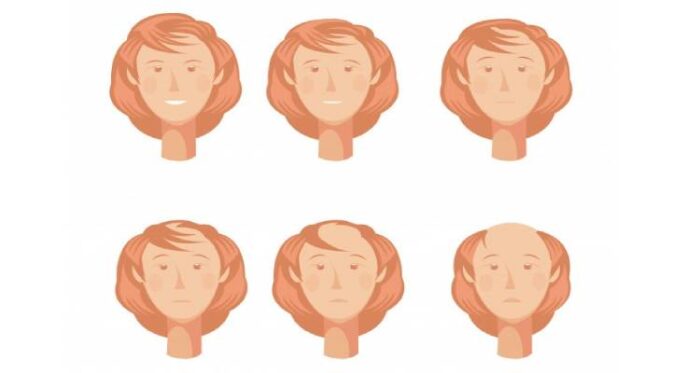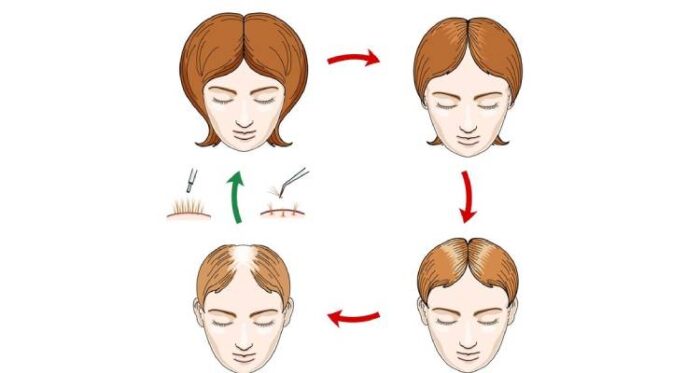It is a nightmare for many of us to have a bald skull, but unfortunately, it’s a natural disaster we can’t deny, and commonly people face this fall season once in their life, and mostly older people are its victims.
Stages of hair loss
Patterned hair loss is the most prevalent cause of hair loss observed after puberty in both genders, usually appearing at the affected sites with gradual thinning, miniaturization, and hair loss.
The loss of hair ranges in degree and magnitude, and there are various phases from the stages of early frontotemporal recession to the residual occipital band level.
Norwood Scale of Hair Loss

The Norwood (or Hamilton-Norwood) scale is the leading method for classifying the level of male calfless in patterns.
Men usually lose their hair over several decades in one of many traditional trends. The Norwood scale gives readily cited photographs that show multiple balding phases.
There are also other grading scales for physicians, scientists, and hair transplantation surgeons. Some classification scales provide either gender or emphasis on female baldness.
The Norwood scale, however, is the measurement that clinicians most frequently used to address male baldness. It offers a focal point for diagnosing the level of baldness, exploring therapeutic strategies, and evaluating treatment efficacy.
Stages of Norwood scale of hair loss
There are seven stages of hair loss on the Norwood scale. Each step tests hair loss incidence and trend.
Stages 1
The first stage of hair loss is no noticeable loss of hair or a hairline recession.
Stage 2
The hairline around the temple is slightly heritable. The second stage of hair loss is regarded as a grown-up or adult hairline, too.
Stage 3
In this stage of hair loss, the first symptoms of balding of clinical meaning emerge. At both temples, the hairline becomes deeply recessed, resembling an M, U, or V shape. Fully naked or infrequently coated with hair are the recessed spots.
Stage 3 Vertex
The hairline persists in stage 2, but on the top of the scalp, there is considerable hair loss (the vertex).
Stage 4
The fourth stage of hair loss is the recession of the hairline is more extreme than in step 2, and the vertex has thin hair or no hair. A band of hair that connects to the hair remaining on the sides of the scalp divides the two areas of hair loss.
Stage 5
The two hair loss zones are bigger than in stage 4. They are still segregated, but the band of hair is thinner and sparser between them.
Stage 6
At the temples, the balding regions join the balding zone at the vertex. The fifth stage of hair loss is a band of hair that is either gone or thin over the top of the head.
Stage 7
In the last stage in hair loss, only a band of hair that goes across the sides of the head remains, the most serious level of hair loss. Usually, this hair is not thick and can be thin.
Norwood Class A
A significantly distinct and less common progression of hair loss is the class A variant of the Norwood scale. The key variations are that without leaving an island of hair in the center.
The hairline recedes equally, and at the vertex, there is no bald patch. Instead, from front to back, the hairline advances directly.
Women hair loss pattern

Ludwig’s scale for women
Men are more prone to hair loss, but in fact, women also suffer this terrible condition. The causes behind the female hair loss trend are not well known.
Still, they may be associated with age, hormonal fluctuations, or a history of male or female pattern baldness in the family background. Hair loss in all facets of life may have a deeply detrimental effect.
In both professional and personal settings, individuals who experience can find it hard to feel secure, optimistic, and healthy. Women are especially vulnerable to hair loss, as well as the harmful social and occupational side effects that may occur as a result, according to data compiled by several national and international health agencies.
A progressive disorder is female pattern hair loss. This suggests that with a consistently expanding portion and diffuse thinning overall, women with hair loss will see their condition worsen over time. Hair restoration practitioners also use the Ludwig Rating Scale to help women recognize and categorize their hair loss.
Three key considerations in the diagnosis and care of female hair loss allow both patients and doctors to understand the Ludwig Scale better:
The degree to which hair has been lost already.
The risk in the future for further hair loss.
The highest recovery course.

Level I
This is known as minimal thinning, using various hairstyling techniques this can be camouflaged. Hair loss can be so mild at this point that it goes unreported. Usually, the hair of a woman would look shorter at this point, but the front hairline does not recede.
Level II
This process is known as mild hair loss. Women can note decreased volume and a widening of their portion in this group. More of the scalp can become visible, and there could be a slight spike in shedding.
Level III
This form of hair loss is often known as diffuse thinning and causes a see-through appearance on the top of the scalp. This is the unusual, most extreme form of hair loss for women, and with hair shaping methods, it is hard to conceal.
[Read Top 10 Best Hair Growth Products for Men and Women’s ]
Telogen Phase of the hair cycle
You do not know that in a complicated loop, the hair on your head, arms, face, and everywhere else on your body is continuously moving through one of four levels.
Rising from under the skin, hair known as a follicle extends from a base. And it cycles through four phases from the moment each hair begins to develop to the time it falls out several years later: anagen, catagen, telogen, and oxygen.
The development period, which will last between two and seven years, is the first phase, anagen. This stage and its period decide how long the hair gets. The catagen stage comes next, also referred to as the regression phase, which only lasts about 10 days.
The hair follicle shrinks and is removed from the dermal papilla during this time. Telogen, which lasts about three months, is the third phase. oxygen, the fourth and final step, is where the hair finally splits and falls out.
The resting hair stays in the follicle during telogen until the development of a new anagen hair drives it out. The telogen process is the hair follicle’s sleeping phase.
This process lasts for hairs on the scalp for around 100 days and hairs on the eyebrow, eyelash, arm, and leg for much longer. For any particular point in time, 10% of all hair is in the telogen process.
The hair follicle is completely at rest during this process, and the club hair is fully developed. In this process, pulling a hair out will expose a solid, rough, dried, white substance at the root.
Something that interrupts the hair growth cycle will induce the telogen process to reach more hairs. As this occurs, a few months after the hairs reach the exogenous process, a larger amount of hair will be shed.
This excessive shedding is referred to as telogen effluvium, and although hair loss is diffuse, certain individuals may find more loss near the front of the scalp.
Telogen Effluvium
Around 85% to 90% of the hairs on the average person’s head are actively developing at any given time (the anagen phase), and the others are resting (the telogen phase).
Normally, for two to four years, hair is in the anagen phase, then reaches the telogen phase, rests for about two to four months, and then falls out and is replaced by new, growing hair. Naturally, the average person loses about 100 hairs every day.
Anybody shifts or shock drives more hairs into the telogen process in an organism with telogen effluvium. Usually, approximately 30 percent of the hair ceases developing in this state and goes into the resting process before dropping out. So if you have telogen effluvium, you will lose 300 hairs a day on average, instead of 100 hairs a day.
A variety of multiple incidents can cause Telogen effluvium, including:
Significant trauma to a physical condition
Significant emotional burden
Extreme fever, serious pneumonia, or some other disease
The Extreme Loss of Weight
Extreme diet shift
Abrupt hormonal changes, particularly those associated with menopause and childbirth
Iron Inadequacy
Hypothyroidism or hyperthyroidism
Certain drugs
Surgery
You may not experience any hair loss until two to four months after the incident that caused the issue because hairs that reach the telegenic process rest in place for two to four months before falling out. The period of telogen effluvium normally reaches six months, while some cases last longer.
While it can be scary to lose a significant amount of hair within a short period, the disorder is typically temporary. Each hair that is forced into the telogen process prematurely is replaced by a new hair that is developing.
So there is no chance of total baldness. Since the hair on the scalp grows slowly, for a while, the hair will feel or appear thinner than normal, but as the new hairs grow in, fullness may return.
Usually occurs two to four months after the incident that caused the problem and lasts for around six months. Immediately after the hair falls out, new hair starts to grow, but noticeable development cannot be seen for several months.
Signs of hair loss
You’ll find more hair than normal collecting on your pillowcase, on the tub or bathroom tile, and in your hairbrush, if you have telogen effluvium. Your hair on your scalp might feel or look less thick than normal. The lack of hair is always gradual, however, and most individuals do not note something unusual in hair.
Assessment
Based on medical records and an examination of the scalp and hair, most cases of telogen effluvium can be diagnosed. There can be noticeable thinning spots if the hair loss has been going on for many months, but sometimes the hair loss is not severe enough for a doctor to identify. You actually don’t have Telogen Effluvium if you have large bald spots.
You definitely have telogen effluvium if the doctor softly plucks any of the hairs on your scalp, and four or five hairs fall out. In the telogen process, the hairs will still appear like hairs; at the end that was in the scalp, they will have a white bulb and will not have a gel-like coating around the end of the hair.
You might be asked to accumulate and count all the hair that comes out of your head over a 24-hour span to see if the hair loss is very excessive.
It is considered natural to lose less than 100 hairs daily. Every one or two weeks, you will even be asked to accumulate and count missing hair and see when the shedding begins to decrease.
On certain limited occasions, a biopsy of the scalp can be performed where there is evidence to question the diagnosis. A small portion of the scalp that contains multiple hair follicles is cut and analyzed under a microscope in this process.
Your doctor can also do blood testing to check for problems that may lead to hair loss, such as thyroid irregularities.
Therapy of hair loss
No therapy has been proved successful for active telogen effluvium. It is possible to correct certain causes of the condition. If you have a bad diet, for instance, visit a dietician to help you balance it.
Speak to the doctor to see whether the drug can be stopped if hair loss has begun after you have started taking a different medication. On many occasions, however, the cause is a single incident in the past, and you should expect the hair to grow back.
Treatment of hair loss without a prescription
The treatment of hair loss without prescription includes:
Laser tools
Different brushes, combs, and other products emit laser light and are sold as hair loss therapy. These devices can stimulate hair development, but this has not been proved clinically
This drug (sold under the Rogaine brand name) will stop hair from thinning directly on the scalp. It may also promote hair development on the skin. It may be mixed with other drugs.
Prescription therapy

Your doctor will prescribe the prescribed medicine Finasteride based on the seriousness of the hair loss and the experience with OTC therapies (Proscar, Propecia).
Finasteride is a U.S.-approved pill. Administration of diet and drugs to help men with hair loss. According to the American Academy of Dermatology, hair loss is slower in approximately 86% of men and promotes development in approximately 65% of men.
Drug treatments for the treatment of hair loss are also available, including:
1) Hair transplantation
Sections of the scalp with successful hair production are extracted and hair follicles transplanted to the balding regions.
2) Reduction of scalp
Any of the bald scalps is cut surgically and healthy hair growth portions of the scalp are placed closely together. This is feasible in tandem with a hair transplant.
3) Expansion of hair
Devices for around three or four weeks are implanted under the scalp to extend the tissue. Which should be performed before a drop of the scalp or as an independent procedure.
4) Micropigmentation of the skin
Minor tattoos may be added to the scalp to allow a shaved head look.
Conclusion
The Norwood scale is an instrument of finding the stages of hair loss to assess the level of male pattern baldness, for you and your physicians. In the early phases, medicines can be used to manage hair loss. There are many surgical choices in the later stages.
READ THIS NEXT
Why My Antidepressants Not Working
How to Lose 30 Pounds in 2 Months
How to Lose 15 Pounds in a Month
22 Super Health Benefits of Mango Juice
Top 25 Full Body Workout Every day At Home

Comments are closed.